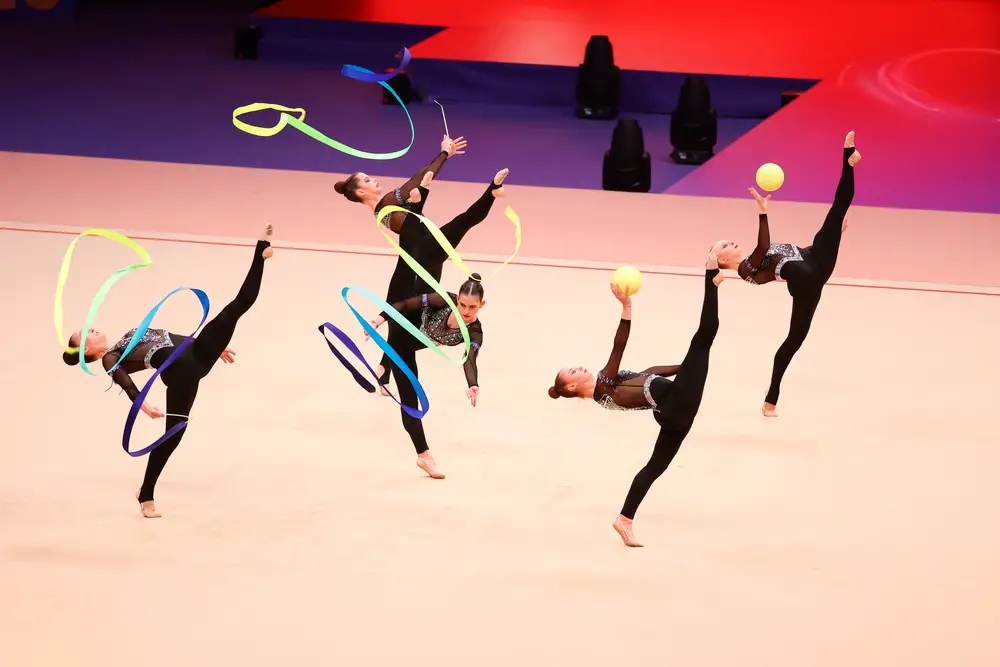Rhythmic gymnastics is a sport that combines elements of ballet, gymnastics and dance, using apparatus such as rope, hoop, ball, mallets and ribbon.
Born in the 19th century, this sport has developed rapidly over the years, becoming an Olympic discipline in 1984. And to understand how the sport works, you need to know the rules of rhythmic gymnastics.
That’s why we’ve created this content, which includes rules such as the structure of the competition venue and the penalties applied, for example. Each rhythmic gymnastics rule plays a crucial role in the sport.
Check it out!
Open your Betano account and get up to 1,000 reais in bonuses.
PIX payments, live games and super odds!
Click here to open your account!

Rhythmic gymnastics rules: complete list
- Competition venue;
- Duration
- Equipment;
- Scoring;
- Gymnasts;
- Infractions and penalties;
- Uniforms and presentations;
- Judging and refereeing;
- Competitions and categories;
- Preparation.
Rhythmic gymnastics rules: competition venue
The competition venue for rhythmic gymnastics must have specific dimensions to ensure the safety and performance of the gymnasts.
The competition mat must measure 13 x 13 meters, with an additional safety area of at least 1 meter around it. This space is covered by a special mat that guarantees cushioning for the gymnasts’ movements, preventing injuries.
In addition, the ceiling of the competition venue must be at least eight meters high to allow high throws from the apparatus without risk.
The lighting in the area must be uniform and sufficient to ensure adequate visibility during the performances.
The warm-up and preparation area should also be close to the competition venue, allowing the athletes to be ready for their performance routines.
Rhythmic gymnastics rules: duration
The duration of performances in rhythmic gymnastics varies according to the category:
- In the individual competitions, the routines last from 1 minute 15 seconds to 1 minute 30 seconds.
- In the ensemble competitions, the duration of the performances is between 2 minutes and 15 seconds and 2 minutes and 30 seconds.
These times are strictly controlled, and any deviation can result in penalties and loss of points.
Precision in executing the movements within the stipulated time is one of the aspects assessed by the judges, contributing to the final score of the performance!
Rhythmic gymnastics rules: equipment
Rhythmic gymnastics uses five main pieces of equipment: rope, hoop, ball, mallets and ribbon.
These pieces of equipment are chosen for each Olympic cycle by the International Gymnastics Federation (FIG). Check them out:
- Rope: made of synthetic material or hemp, its length should be adjustable according to the gymnast’s height. Ropes routines include jumps, balances and throws.
- Bow: with a diameter of between 80 and 90 centimeters, the bow is made of plastic or wood. Routines with the hoop emphasize rotational movements, throws and passes through the hoop.
- Ball: made of rubber or synthetic material, the ball should have a diameter of 18 to 20 centimeters. The routines with the ball are rolling, throwing and swinging movements.
- Apples: each apple weighs between 150 and 300 grams and measures 40 to 50 centimeters in length. Hoop routines involve manipulation, throws and catches.
- Ribbon: with a length of 6 meters for senior gymnasts and 5 meters for junior gymnasts, the ribbon is made of satin or another lightweight material. Routines with the ribbon include serpentines, spirals and throws.
Rhythmic gymnastics rules: scoring
Scores in rhythmic gymnastics are calculated based on three main criteria: difficulty, execution and artistic component. Check them out!
- Difficulty: evaluates the complexity of the movements performed. The sum of the difficulty values of the movements makes up the score.
- Execution: evaluates the precision and quality of the movements. Each error or inaccuracy results in deductions. The grade is the starting score (10 points) minus deductions.
- Artistic component: evaluates the expressiveness, creativity and harmony of the routine. The artistic score varies from 0 to 10 points, depending on the judges’ assessment.
Rhythmic gymnastics rules: gymnasts
Rhythmic gymnastics competitions can be individual or team competitions.
In individual competitions, each gymnast performs alone. In team competitions, five gymnasts per team take part.
In the sets, the gymnasts must coordinate their movements precisely, ensuring synchrony and cooperation. The interaction between the gymnasts and the joint use of the apparatus are crucial aspects for a successful performance.
Rhythmic gymnastics rules: infractions and penalties
Infractions in rhythmic gymnastics result in penalties that affect the gymnasts’ final score. The main infractions are:
- Leaving the competition area: this happens when a gymnast or apparatus leaves the demarcated area, and deductions are applied to the execution mark.
- Fall of apparatus: every time an apparatus falls to the floor without control, there is a significant deduction in the execution mark.
- Synchronization error: in teams, any deviation in synchronization between the gymnasts results in deductions.
- Exceeding the presentation time: presentations that exceed the stipulated time result in deductions in the points cannot take place.
- Technical faults: technical errors, such as poorly executed movements or incomplete elements, also result in deductions from the execution grade.
Rhythmic gymnastics rules: uniforms and presentations
The gymnasts’ uniforms must be appropriate and beautiful. They are generally swimsuits that allow freedom of movement and feature artistic design.
Unsuitable uniforms or those that do not meet FIG standards may result in penalties.
In addition to the uniform, the presentation as a whole, including make-up, hair and props, must be in harmony with the theme of the routine, contributing to the score in the artistic component.
Rhythmic gymnastics rules: judging and refereeing
Rhythmic gymnastics performances are judged by a panel of judges, who are divided into groups to assess different aspects of the routine: difficulty, execution and artistry.
Each group of judges then gives specific marks which are combined to form the final score.
The judging panel is made up of qualified judges certified by the FIG, guaranteeing impartiality and accuracy in the evaluations.
Any contestation of scores must be formally submitted and will be analyzed by the competition’s technical committee.
Rhythmic gymnastics rules: competitions and categories
Rhythmic gymnastics competitions are held at different levels: local, national and international. The main international competitions include the Olympic Games, World Championships and World Cups.
The categories vary according to the age and skill level of the gymnasts. The main ones are
- Pre-kindergarten: up to 9 years old.
- Infant: 9 to 12 years old.
- Youth: 12 to 15 years old.
- Senior: over 15 years old.
Each category has specific rules regarding the choice of apparatus and the complexity of the movements.
Rhythmic gymnastics rules: preparation
Preparing for rhythmic gymnastics competitions requires a rigorous training regime, which includes flexibility, strength, endurance and technique exercises. In addition to physical training, gymnasts also work intensively on choreography and artistic expression.
Coaches and choreographers also play essential roles in the gymnasts’ preparation, helping with the selection of music, the creation of routines and technical improvement.
Mental training is also key to developing concentration and emotional control during competitions!

Rhythmic gymnastics rules: complete list
- Competition venue;
- Duration
- Equipment;
- Scoring;
- Gymnasts;
- Infractions and penalties;
- Uniforms and presentations;
- Judging and refereeing;
- Competitions and categories;
- Preparation.
These are the rules of rhythmic gymnastics! If you enjoyed learning more about the sport, be sure to keep following the site to stay up to date with everything about the sports world!



